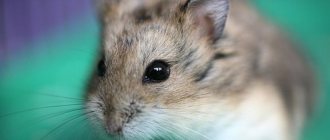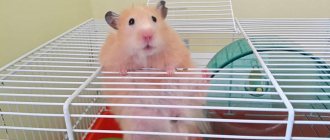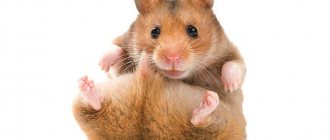Reasons for the animal's behavior
The hamster is a representative of the rodent order. Nature arranges it in such a way that an animal constantly needs to chew on something. This need is genetic. And there is nothing to be done about it.
Many beginning hamster breeders think that only Djungarian and Syrian hamsters actively chew cages. However, this behavior is inherent in hamsters of all breeds, it’s just more pronounced in Djungarians and Syrians.
Why does a short-legged pet attack the cage? There are a number of reasons for this.
Hunger
The hamster has a fast metabolism, he constantly wants to eat when he is not sleeping. Imagine your pet wakes up and finds that the bowl is empty and all the supplies from the pantry have been eaten. All he can do is chew on the cage, waiting for the owner to come and feed him.
Boredom
Wild hamsters have a busy life, they are constantly busy: digging holes, looking for food, stocking up, hunting. The domestic furry is somewhat limited in freedom of action.
If there is little entertainment for the hamster in the cage, the animal has no place to develop vigorous activity, it becomes bored. The animal begins to intensively chew on the walls of the apartment to compensate for the lack of physical activity.
Hamsters' front teeth continue to grow throughout life.
Grinding down teeth
Hamsters have front teeth - incisors - that have no roots and grow throughout their lives. In addition, the enamel covers the teeth unevenly: on the front side its layer is thick and strong, on the back it is thin. When a hamster chews rough food, its teeth wear down and shorten naturally.
If a pet's diet contains a lot of soft food, it begins to chew on surrounding objects, including the bars of the cage.
IMPORTANT If a hamster's teeth grow too long, they will injure the oral cavity, the animal will not be able to eat normally and will die of starvation.
In cases where the hamster’s teeth grow quickly and the hamster cannot grind them down naturally, contact a veterinarian for correction. Usually this procedure is painless and does not last long. However, it is still not worth bringing your pet to this state.
Lack of sleep
Daytime sleep is a sacred time for a hamster, and if it is disturbed, the animal loses its usual routine, its mood deteriorates, it becomes irritable and restless. An attack on the cell in this case will be a way to relieve accumulated tension.
small cage
Under natural conditions, hamsters move across a vast territory, running several kilometers a day. The size of a small cage does not allow a pet rodent to properly warm up and limits its movements.
These are the main points that explain why the animal gnaws its apartments.
A hamster can get paint poisoning if this behavior is not stopped.
Nuances of weaning a hamster
Before replacing your hamster's cage, you need to pay attention to its condition and check whether it meets the following requirements:
- Has enough space to accommodate the animal.
- Equipped with tunnels, slides and a wheel.
In the behavior of dzhungariks there is a pronounced tendency to escape, so they gnaw on the bars in the area where they exit the cage. Representatives of the Syrian breed are considered to be calmer, and if they have not chewed on bars before, this behavior may be due to a lack of other activity.
If you find that your hamster has started to engage in this habit, offer him a stick or twig to replace one activity with another.
Maintain gentle persistence and be attentive to the animal's wishes.
Ways to solve the problem
In addition to the inconvenience for owners caused by loud grinding, the danger of constantly gnawing metal rods is that the animal can:
- damage gums and severely break teeth;
- poisoned by the paint that covers the cell;
- get stuck;
- get hurt by escaping from your home.
To avoid such unpleasant situations, check out the common ways to pacify your pet, redirect its irrepressible energy in another direction and prevent damage to the hamster’s abode.
Has your hamster ever escaped?
Walks and communication
By nature, most hamsters are individualists and self-sufficient animals. And although they like to be alone, a long absence of human contact leads to the fact that the animals “run wild” and try to escape from the cage as quickly as possible. The mania for escape is especially strong among Djungarians.
To prevent this from happening, pick up your pet more often, talk to it, and release it into the “big world.” The hamster is curious, he will explore the room with great interest.
HELP If you are afraid that you will not be able to keep track of your pet and he will run away, buy a special device - a walking ball. In it, the hamster will be able to explore the room freely and safely.
Diversify the animal's leisure time, build an obstacle course, labyrinths, tunnels. After active climbing, the hamster will remain happy and the cage intact.
The rods can be treated with aloe juice
Treats
To regularly grind teeth and prevent chewing of twigs, offer your pet healthy treats:
- dried fruits from apples or pears;
- nuts;
- mineral stone;
- branches of fruit trees and shrubs (apple, apricot, currant).
Usually the animal quickly switches to the offered treat.
Alternative methods
If the hamster continues to encroach on its home, try treating the rods with safe but not pleasant-tasting substances:
- lemon juice;
- aloe juice;
- natural apple cider vinegar.
Or spray a special “Anti-gryzin” biospray, which is sold in pet stores.
IMPORTANT Before treatment, remove the hamster from the cage, return it back when the treated surfaces are completely dry.
Do not apply too much repellent, otherwise the animal risks serious food poisoning or allergies.
The effectiveness of this method depends on the individual characteristics of your furry. Among hamsters there are individuals on whom the treatment of rods has no effect.
If your hamster is cramped in a cage, buy a more spacious home, install a larger running wheel, and let the animal exercise in it more often.
Some owners do something radical - they move the rodent into a plastic container or aquarium. The main thing is that these structures have an acceptable level of ventilation. Be prepared for the fact that the animal, driven by ancient instinct, will gnaw off all the plastic accessories in a new place.
Subtleties of how to wean a pet
Take a comprehensive approach to solving the problem . Combine several methods: mineral stone, running wheel, intense walks, treats.
Learn to sense your pet's needs by observing him. If the animal is actively gnawing on the cage when you sit down for lunch or dinner, it means that it is either hungry or attracting attention by begging for a treat.
If he gnaws at the door area in the evenings, it means he’s asking for a walk.
Adjust the rodent's diet, add more solid food. Attach sticks to the walls of the cage, and during the next attack on the rods, offer to gnaw on the branches.
In the evening, actively walk your hamster, at least for a quarter of an hour.
At night, provide your fluffy with pieces of cardboard, toilet paper rolls, and wooden medical spatulas. Or give him a white paper napkin for fun and let him wet it.
The main thing is that the active rodent has something to do at night.
Is this harmful for the pet?
In addition to the fact that a furry homebody will constantly wake you and your family with its night fussing and loud grinding, which is quite unpleasant, especially if it happens regularly, there is also a danger in such actions for the animal itself.
Firstly, the material of the cage is strong enough to not only wear down, but also break teeth - after all, in nature, a rodent usually uses pieces of wood or crunchy food, much softer than metal rods.
Secondly, the rods are often covered with paint, which gradually begins to crumble and get into the stomach. And even if it does not lead to health problems, there is no benefit from such a “food additive”.
Proper nutrition
There is a wide variety of food for rodents on display at pet stores. However, despite what the labels say, not all of them are created equal. Cheap food is not suitable for feeding hamsters - they are usually of poor quality, incorrectly balanced, and do not contain all the necessary substances and vitamins. There have been cases where rodent poison was found in food, which caused the death of pets.
For normal functioning, hamsters need balanced dry food. It should include cereals, plant seeds, herbs and flowers, as well as protein supplements in the form of dried insects.
It is important to give hamsters allowed vegetables and fruits. You can feed hamsters cucumber, zucchini, broccoli, cauliflower, lettuce, turnips, radish
Types of hamsters that are not predisposed to diabetes can be given pumpkin, carrots, fruits and dried fruits.
It is forbidden to give onions, white cabbage, sorrel.
Rhythm of life
This has been more or less sorted out. But a completely logical question remains. You buy special sharpeners for incisors at the pet store, lay out various twigs, twigs, and put up stumps that seem quite suitable to you. Why does the hamster chew on the cage with the same persistence? The reason is quite simple, the rods are very well secured and therefore comfortable for the pet. You can correct this situation and tie several wooden sticks on the cage machines. Most likely, the hamster will switch to them.
How to extend the life of a Djungarian hamster: basic rules
If your task is to significantly extend the life of your hamster, providing him with the maximum possible longevity, then take each of the above points seriously.
- Respect the natural environment of dwarfs, which do not tolerate bright light. To do this, place the cage away from the window so that the animal does not receive unnecessary stress from excess daylight.
- Take care of your pet's hygiene. Since the rodent spends most of its time in the cage, constantly clean it. At least once a week it is necessary to wash the entire house, periodically change the bedding there and remove excrement. This will ensure clean and fresh air around the cage space.
- “We are what we eat” is a phrase that also applies to Djungarians. Feed him exclusively healthy food, while relying on the animal’s natural preferences. Sometimes give him harmless treats in the form of a piece of banana or apple. This will significantly lift the animal’s mood and give a new boost of energy.
- The basis of nutrition should be grains and legumes, such as corn grains, peas, seeds, nuts, rice grains and wheat.
- As mentioned earlier, you can purchase ready-made nutritional mixtures at pet stores; these kits include all the useful components for your pet.
- Do not exclude meat from his diet, which is rich in protein and healthy fats.
All about dzhungarikas - video
If all of the above conditions are met, your pet can live a long and happy life. In addition to the basic rules of care, do not forget about love and care. These little creatures are constantly in need of someone's help, so always be ready to provide it.
Choosing a cell
Today, buyers have a good choice. Plastic, iron and wooden cages have their pros and cons. Most often, the strongest ones are chosen, which will not be damaged by the sharp teeth of rodents. But this is debatable. If the cage is large enough, it has a wheel and sticks for grinding teeth, then the risk to its walls is small. And if the hamster did get to the bars at night, then the sound will be much muffled and, most likely, will not wake you up. In the morning you will find traces of damage and take action. You can also tie fruit tree sticks from the inside to protect the cage from attack.
Useful tips
To make the search for the fugitive successful, follow simple rules:
- If there are other pets living in the apartment, move them away from the place where the hamster is supposed to be.
- When using mousetraps, be sure to remove them so that the animal does not get caught in them.
- Once you find an animal, limit its movement around the apartment. To do this, close all exits from the room.
- To avoid scaring the tiny creature, do not make loud or harsh sounds.
- Quite rarely, a hamster can be found in the folds of clothes, towels or bed linen - he climbs there to keep warm.
Check the cage regularly to eliminate defects in a timely manner, and ensure that the door is closed tightly. Make sure your pet is comfortable in his house and there are no irritating factors nearby. Give the animal more time and buy toys if necessary. The best way to catch a hamster is to prevent it from escaping.
Grinding down teeth
You can seek the help of a veterinarian. It quickly and painlessly shortens incisors. But you will have to do this quite often, so it is better to leave it as a last resort. It is best to offer the hamster some more suitable objects for grinding down his teeth than rods and cage equipment. The pet store has special stones for grinding teeth, roots and twigs. You can prepare them yourself. To do this, take apple trees, lilacs and currants. Tie the iron rods with them from the inside. This will not solve the problem, but the teeth will grind down much more quietly.











